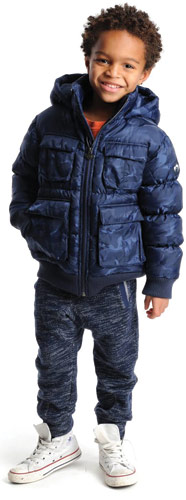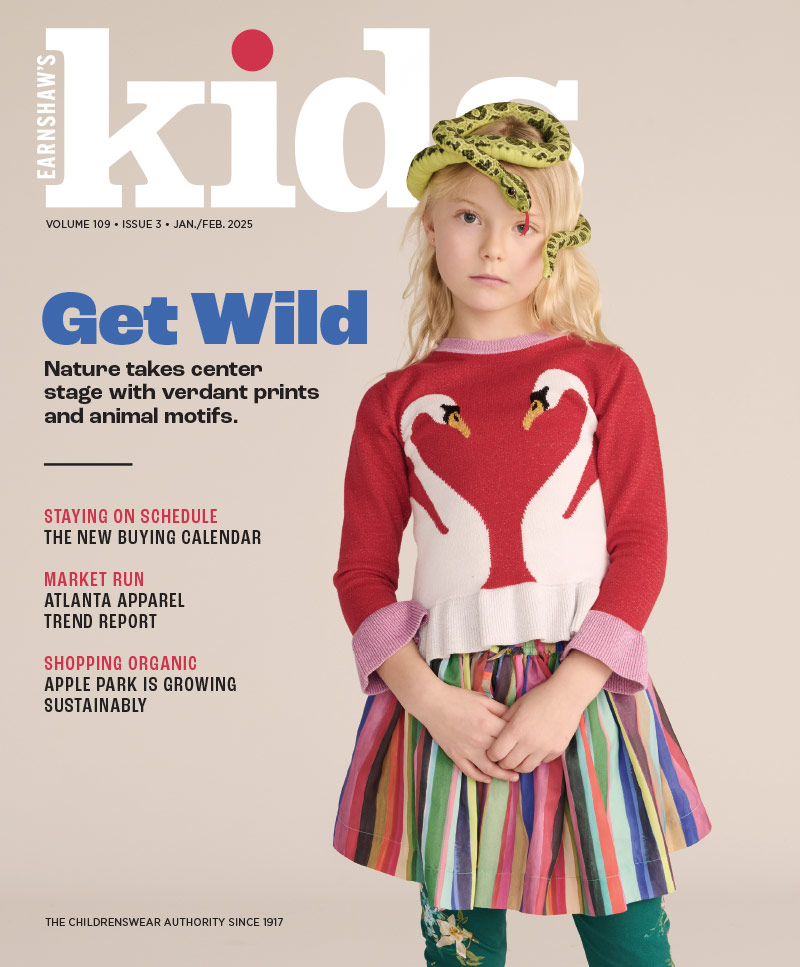As a dip in sales—and a rise in mercury—pose a flurry of challenges for winter wear, experts reveal how to weather the hot-and-cold category.
 When it comes to outerwear, specialty retailers may be feeling a bit snowed under. Thanks to an avalanche of market forces, from warmer-than-usual weather to can’t-be-beat prices at big box shops, consumers are giving boutiques the cold shoulder. According to the NPD Group’s Consumer Tracking Service, retail sales of outwear for infants, toddlers, girls and boys have dropped in the last year, down 6 percent to $1.7 billion as of October 2015 (from the same period last year).
When it comes to outerwear, specialty retailers may be feeling a bit snowed under. Thanks to an avalanche of market forces, from warmer-than-usual weather to can’t-be-beat prices at big box shops, consumers are giving boutiques the cold shoulder. According to the NPD Group’s Consumer Tracking Service, retail sales of outwear for infants, toddlers, girls and boys have dropped in the last year, down 6 percent to $1.7 billion as of October 2015 (from the same period last year).
Fall’s balmy climate isn’t the only reason for the decline in sales, says Marshal Cohen, chief industry analyst for fashion at NPD. “Consumers are no longer buying ahead of need,” he explains. “They don’t buy the way the retail calendar works. They are much more reactive shoppers and now have the mentality, ‘When I need it, I’ll buy it.’” Childrenswear management consultant Christine McCarthy seconds the motion. “Parents don’t look for [outerwear] until it is cold and snowing out, and they realize that last year’s item doesn’t fit,” she agrees.
The problem for specialty stores? By the time January’s blizzards hit, coats and jackets have been drastically marked down—especially at department stores and national chains. “Unfortunately, outerwear is always on sale with larger retailers, and that is what boutiques compete with,” McCarthy adds, pointing to vendors like The North Face and L.L. Bean as suppliers that drive outerwear business away from boutiques.
But the forecast isn’t entirely bleak for the outerwear category. As always, retailers who offer shoppers what they want will stay afloat. Below, experts reveal how.
Value First
While it may be tempting to try and match the low prices at nearby big box shops, retail pros advise against the strategy. Why? “Price is less of an issue, since boutique shoppers aren’t generally looking for bargains; they are looking for something special,” explains Lorri Devlin, owner of CapeKids in Mashpee, MA. As Devlin notes, the emotional quotient can never be left out of a childrenswear purchase. “The overarching driving factor is the customer’s desire to express their love and affection for their little ones.”
While that may mean different things to different parents, a few factors are almost always key. At Miller’s in Mamaroneck, NY, comfort reigns supreme. “If the child is not comfortable or a coat is too big, they will not wear it,” explains owner Brooke Andrews. Second on the list is quality. “A family at Miller’s will not spend money on something that will not hold up or perform for at least one season,” she says.
Brand-conscious consumers are also seeking big names in outerwear, such as Appaman, Widgeon, The North Face and Andy & Evan. At Little Threads boutique in Chicago, customers love Appaman for its “warmth, fabulous colors and ease of wear. If we don’t have them in stock, we hear from [our customers],” says Owner Joanne Krakora. At Miller’s, this season’s bestselling coat is the Hi Loft Down from Patagonia, which Andrews describes as “one of the warmest, best-made down coats for kids.”
And as in all apparel purchases, on-trend styling is crucial. Puffer coats and animal-shaped hats are still an across-the-board bestseller, but “hooded garments aren’t as popular lately,” notes Devlin. At Miller’s, ski wear outfitted in neon colors is big for both boys and girls.
Lastly, Krakora recommends keeping the age of the child in mind when it comes to outerwear purchases. “Parents of babies are concerned about fitting the child in the child seat, while still keeping them warm,” she says. “Those with 2- to 6-year-olds want the coat to be cute, but still functional. And the parents of kids ages 6-plus want quality for the price.”
Timing is Everything
To keep outerwear moving briskly off the sales floor, retailers must be sure to schedule their orders and shipments accordingly. According to McCarthy, outerwear typically delivers in late August and remains on the floor until February, “with sales happening constantly.”
Weather, of course, is a major factor as to when customers begin to buy coats and scarves. “A cold snap in September or October will encourage sales,” says Lynn Husum, co-founder of Appaman. Similarly, she adds, “A prior cold winter will present early sales in August.” Winter coats can be showcased even sooner—as early as the last week in July, says Chris Oldland, president of Hatley. “When the temperature drops, it happens fast, and you don’t want to miss back-to-school,” he says. “At the same time, some pieces are expensive and it might take two visits before a purchase is made.”
However, some suppliers like Andy & Evan are finding showcasing winter wear too soon can turn off shoppers—and can ultimately become a burden for the retailer. “Traditionally, retailers bring in outerwear during the end of the summer, but I’ve seen a shift away from this and now more are bringing [it] in September and October,” says Isaac Maleh, executive vice president of sales and merchandising. “This keeps the goods fresh by the time the weather gets cold. Since they do take up a lot of space and have higher tickets, retailers try to move the majority by the end of the holiday season.”
While it may make sense to stock transitional items like fleece and jersey lightweight jackets in August, outerwear needs to deliver in September for the selling season to be effective, says McCarthy. And even if retailers want to buck the traditional calendar and display heavy winter goods at a later date, McCarthy notes that some manufacturers may not be on board. “Retailers don’t necessarily dictate the delivery window unless they specifically ask a manufacturer to hold their shipment and not deliver until a certain time,” she notes.
Manage Markdowns
In an ideal world, all outerwear would be sold at full price, but short of that lofty ambition, experts recommend a wait-and-see approach before slashing prices. After all, if a cold snap drives shoppers to the stores in January, marked-down merchandise means lost dollars. “The fact is that retailers are still in the mindset that they need to mark down and move out goods right after the holidays and in most cases, start before,” notes McCarthy. “I am starting to see a trend, though, where boutiques are waiting to mark down winter-specific goods and in some cases, store them for the next year.”
In fact, manufacturers like Appaman encourage their buyers to postpone markdowns as long as possible. “We don’t like to see any markdowns until the goods have been 12 weeks out from start ship date,” says Husum. “This is a hard rule to enforce, but we encourage this from our vendors.” And some retailers that follow this philosophy find that it creates a special opportunity for their customers. “We do a big end-of-season sale in February since most of the vendors we work with do not allow us to break price until this time,” says Andrews of Miller’s.
That being said, any retailer with overstock knows that hanging onto out-of-season merchandise is easier said than done. To avoid a surplus of scarves and coats, retailers must develop a sales strategy that works for their respective businesses. “If your strategy is to be the retailer for a certain brand, you have to buy big to make that statement,” says Oldland of Hatley. “If the brand is popular this can work well. However, with outerwear you need to buy well in advance and if the season is mild, you have to go on sale earlier than planned. I would lean towards buying down the middle…leaving some dollars for open-to-buy.”
Maleh at Andy & Evan suggests retailers adopt a relatively cautious approach and base their buys on the previous year’s numbers and adjust them based on past performance and general trends. “It’s better to be conservative with the upfront buy, and look for ‘in season’ opportunities versus having too much inventory on your floor and hoping the weather gets (and stays) cold early and long enough to help boost outerwear sales,” he advises.
Merchandising Done Right
Most industry insiders agree that creating a distinct outerwear section is essential to success. “People want choice and having to walk around the store to find all the outerwear options does not make sense,” Husum states. Oldland agrees. “People are specifically shopping for outerwear; they don’t stumble across it like daywear,” he notes. “With that said, it’s a missed opportunity not having add-on items that make sense close-by,” he adds.
Nevertheless, retailers that choose to stretch the rules find that flexible merchandising makes their store more interesting. At CapeKids, infant cardigans, matching hats and booties from Susa Creations, a Maine-based company that uses Malden Mills fleece, is showcased under a large poster announcing ‘Snuggle Season.’ “It’s what we call this time of year,” notes Devlin. The display is anchored by a collection of Fingerprints Fisherman sweaters on the store’s center table, which helps to create a seamless transition between outerwear and other children’s winter wear.
Outerwear Equality
Keeping your store’s customers in mind—especially when it comes to gender—is also crucial when it comes to selecting outerwear. “Girls’ [clothing] in the boutique market tends to sell better in stores,” says McCarthy. “Overall, though, it depends on where the store is located and what type of clientele shops in their stores to determine the overall buy.”
That’s certainly the case at CapeKids. “We firmly believe in giving boys a wide variety, but girls consistently outsell boys in every category,” Devlin says. Meanwhile at Miller’s, Andrews reports she typically buys an equal amount of outerwear for girls and boys.
In fact, Husum hints that outerwear may be a category where boys’ sales shine. “If it were up to us, it would be 50/50, but what we hear is that most buyers do 60 percent girls, 40 percent boys,” she says. “They claim moms spend more money on their girls.” However, Appaman’s numbers show a more equal divide. “It may be slightly higher in girl than boy, but the difference is marginal.”
Communication is Key
Whether solids or prints will be a hit depends on how well retailers know their clientele, and communicating with them is essential to
success. For CapeKids, providing look books is the way to go. “Customers love to see the garment on a real child,” explains Devlin. She also finds social media to be a useful tool, by showcasing of her outerwear and special events via Facebook.
Aside from highlighting newly arrived merchandise, social media is also instrumental in proving a boutique’s guarantee of in-stock outerwear—something a big box can’t always do. “Social media in the boutique business plays into a huge part of the overall business in general,” notes McCarthy. “So utilizing that to let your customers know your shipment has come in is very important.” And as Maleh notes, “It’s a great way to offer promotions to the consumer as well as to educate the customer on what differentiates your outerwear (features, price point, etc.) from the competition.”
For some suppliers, however, more traditional forms of communication work best when marketing outerwear. “Social media has become like the Wild West,” quips Husum. “The algorithms change weekly, making it a hard game to conquer.” Instead, Appaman finds success with direct e-mail campaigns.
Of course, no form of virtual communication can replace the value of in-person customer service, especially at the boutique level. “You have to have knowledgeable, trained staff to sell a high-end outerwear product to justify the cost,” affirms Andrews of Miller’s. “You also have to be able to stand behind the products you sell so that customers keep coming back to tell their friends.”
Training staff to demonstrate how a coat’s hood unzips or how to adjust snow pant straps can tip the scale between a sale and no sale. “I have found that with our girls’ selection, having the child actually put the coat on can make all the difference,” says Krakora of Little Threads. “If there’s a cute belt or special collar, the customer won’t be able to tell how it looks and feels without trying it on. Encouraging them to do so is crucial.”
Weather or Not
Even with the best salesmanship, the outerwear market is not without its challenges for boutique buyers. Many retailers cite weather as their No. 1 concern, and with last year’s winter off to a slow start, it remains to be seen whether retailers will be able to sell off their cold weather inventory. NPD’s Cohen does not expect the current season to be a good one for outerwear. “There is too much ground left to catch up,” he explains. “People are more likely to hang on to last year’s merchandise.” While he does not rule out January and February for sales, he believes consumers won’t make as much of an investment in outerwear this season.
What that means for Fall/Winter ’16 outerwear remains to be seen. Shoppers may finally be ready to stock up on coats and scarves, or they may believe the items are unnecessary if they suspect it will be another warm winter. Despite these obstacles, Cohen still believes specialty retailers can use this opportunity to their advantage and compete with the retail behemoths. “Be more localized and give consumers what they want, when they want it,” he advises. “Small retailers can buy what they need, when they need it. They can also carry a unique assortment tailored to their consumers. We call it a ‘long and strong’ selling season: It can be longer, but smarter.” •





 FASHION IS MY PLAYGROUND
FASHION IS MY PLAYGROUND 
 The Chi
The Chi



 The
The

 The top expo for kids and baby
The top expo for kids and baby
 The 2025 Earnie Awards are officially OPEN! I
The 2025 Earnie Awards are officially OPEN! I


 From milestones to everyday magic, @ryleeandc
From milestones to everyday magic, @ryleeandc

 BEST IN SHOW: @milaandrose
Twirl-worthy, pla
BEST IN SHOW: @milaandrose
Twirl-worthy, pla





 This season’s
This season’s



Leave a Comment: